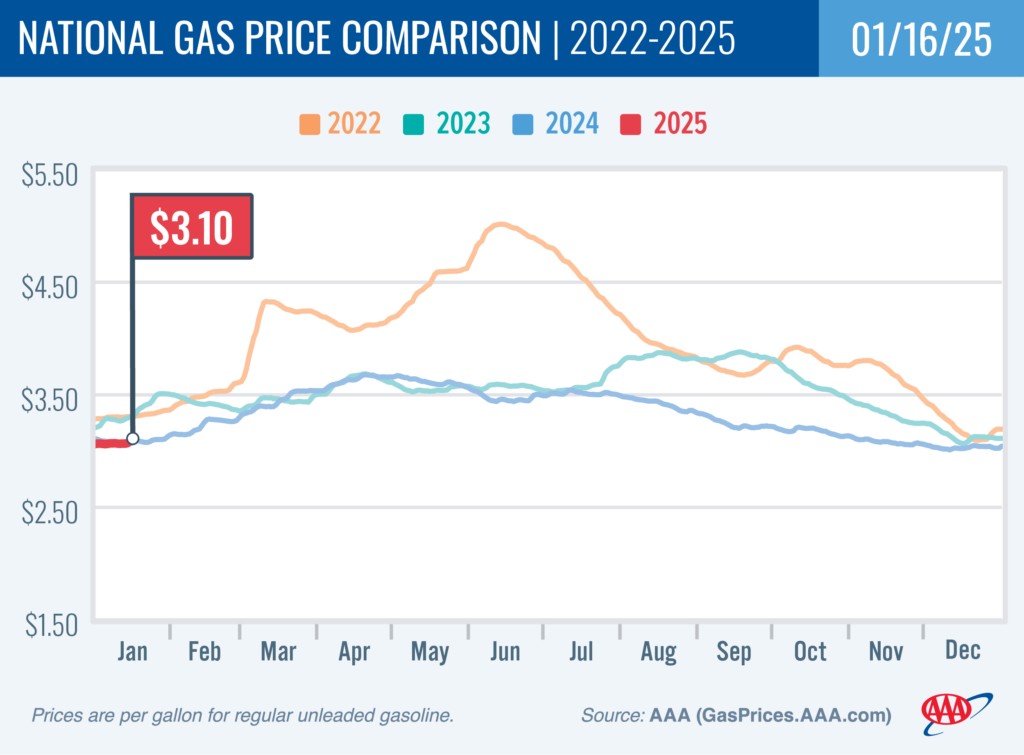Across the United States, motorists are noticing an unwelcome trend at the pump: rising gasoline prices. The national average for a gallon of gas has climbed to $3.10, a four-cent increase since last week, despite oil costs hovering around $80 a barrel. This increase prompts the question: Why Are Gas Prices Going Up even when demand seems low?
 Gas Price Trends and Comparisons
Gas Price Trends and Comparisons
According to AAA spokesperson Andrew Gross, the primary culprit is the increasing cost of oil. “Domestic gasoline demand is low, so why are pump prices creeping higher? Look at the cost of oil,” Gross explains. “Global oil prices have surged due to strong winter heating fuel demand and new U.S. sanctions against Russia’s energy sector. Oil costs account for 56% of what you pay at the pump. So, more expensive oil leads to more expensive gas.” This direct relationship between crude oil prices and gasoline costs means that fluctuations in the global oil market significantly impact what consumers pay to fill up their tanks.
Data from the Energy Information Administration (EIA) supports this analysis. While gasoline demand has slightly decreased from 8.48 million barrels per day to 8.32 million, and total domestic gasoline stocks have increased to 243.6 million barrels, the upward pressure from oil prices is overriding these factors. Gasoline production also saw a rise, averaging 9.3 million barrels daily, yet this supply increase isn’t enough to counteract the oil price surge’s effect on pump prices.
Currently, the national average gas price is $3.10 per gallon. This reflects an eight-cent increase from just a month ago and a three-cent rise compared to the same time last year. These figures underscore the persistent upward trend in gas prices, driven largely by the dynamics of the global oil market.
Oil Market Dynamics Explained
The price of West Texas Intermediate (WTI) crude oil, a key benchmark, closed at $80.04 a barrel on Wednesday, marking a $2.54 increase. EIA data reveals that U.S. crude oil inventories have decreased by 2.0 million barrels, placing current inventory levels at about 6% below the five-year average for this period. This tightening of crude oil supply further contributes to the upward pressure on oil prices, and subsequently, gas prices.
Regional Gas Price and Electric Charging Variations
Gas prices vary significantly across the country. Hawaii currently holds the title for the most expensive gas at $4.54 a gallon, followed by California at $4.41. Other states with high gas prices include Washington, Nevada, and Oregon. Conversely, states like Mississippi and Texas offer some of the lowest gas prices, averaging around $2.66 and $2.68 per gallon respectively.
Interestingly, the cost of electric vehicle (EV) charging also exhibits regional variations. Kansas boasts the lowest public charging rates at 22 cents per kilowatt-hour, while Hawaii has the highest at 51 cents. These disparities highlight the diverse energy landscapes across different states.
For drivers seeking the most current gas prices and electric charging costs along their routes, resources like the AAA TripTik Travel planner provide valuable real-time information, helping them make informed decisions about fuel and charging.
In Conclusion
Ultimately, the rise in gas prices can be primarily attributed to increasing global oil costs, influenced by factors such as winter heating fuel demand and international sanctions. Despite stable domestic gasoline demand and supply metrics, the significant impact of oil prices, which constitute over half of the cost at the pump, dictates the prevailing trend of rising gas prices across the nation.